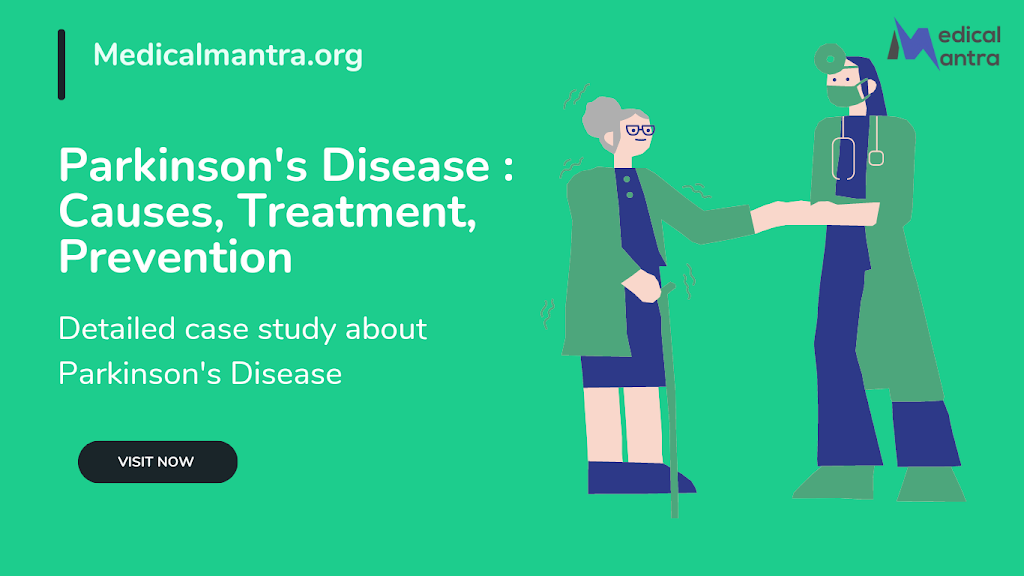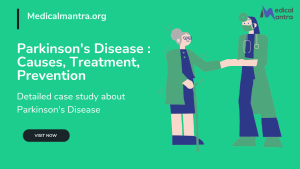Table of Content(toc)
Introduction:-
Parkinson’s disease is a progressive neurological disorder that affects millions of people worldwide. Parkinson’s disease is characterized by a decline in motor functions and other symptoms that can significantly impact an individual’s quality of life. In this comprehensive article, we will study the details of Parkinson’s disease, In this article we will explore the following points.
- Symptoms of Parkinson’s disease,
- Causes of Parkinson’s disease,
- Risk factors of Parkinson’s disease, and
- Available treatment options for Parkinson’s disease.
What is Parkinson’s Disease?
Parkinson’s disease is a chronic and degenerative brain disorder that primarily affects the central nervous system. It is named after Dr. James Parkinson, who first described its symptoms in 1817. The disease occurs due to the gradual loss of dopamine-producing nerve cells in the substantia nigra (The substantia nigra is a critical brain region for the production of dopamine and this neurochemical affects many systems of the central nervous system ranging from movement control, cognitive executive functions, and emotional limbic activity.),
Symptoms of Parkinson’s Disease
The symptoms of Parkinson’s disease often develop slowly and worsen over time. Some of the most common signs include:
1. Tremors: Involuntary shaking of hands, arms, legs, or other body parts, especially at rest.
2. Bradykinesia: Slowness of movement, making simple tasks like walking or getting up from a chair challenging.
3. Muscle Rigidity: Stiffness in the muscles, which can cause pain and limit the range of motion.
4. Postural Instability: Impaired balance and coordination, leading to an increased risk of falls.
5. Speech and Writing Changes: Patients with Parkinson’s Disease may experience reduced volume, slurred speech(Dysarthria often causes slurred or slow speech that can be difficult to understand), and difficulty writing.
6. Micrographia: Handwriting becomes small and cramped.
7. Freezing: Momentary inability to move, often observed when attempting to walk.
Causes and Risk Factors of Parkinson’s Disease
The exact cause of Parkinson’s disease remains unknown, but research suggests that it results from genetic and environmental factors. Some potential risk factors include:
1. Age: The risk of Parkinson’s disease increases with age, typically affecting individuals over 60.
2. Genetics: Certain genetic mutations are associated with an increased risk of developing the condition.
3. Environmental Factors: Exposure to certain toxins or chemicals may play a role in triggering Parkinson’s disease in susceptible individuals.
4. Gender: Men are slightly more likely to develop Parkinson’s disease than women.
Diagnosis of Parkinson’s Disease
Diagnosing Parkinson’s disease can be complex as its early symptoms often overlap with other conditions. Physicians rely on a thorough medical history, neurological examination, and response to medication to make an accurate diagnosis. In some cases, brain imaging techniques such as MRI or DaTSCAN may be used to rule out other disorders.
Treatment for Parkinson’s Disease
While there is no cure for Parkinson’s disease, several treatment options aim to manage its symptoms and improve the patient’s quality of life. These include:
1. Medications: Dopamine-enhancing drugs, such as levodopa, can help manage motor symptoms.
2. Physical Therapy: Exercises and physical therapy can improve flexibility, balance, and mobility.
3. Occupational Therapy: Techniques to adapt daily activities and improve independence.
4. Speech Therapy: To address speech and swallowing difficulties.
5. Deep Brain Stimulation (DBS): A surgical procedure that can help control symptoms in advanced cases.
People with Parkinson’s-disease
Coping with Parkinson’s disease requires a comprehensive approach. Patients are encouraged to:
1. Stay Active: Regular exercise can help manage symptoms and improve overall well-being.
2. Maintain a Healthy Diet: A balanced diet rich in antioxidants and omega-3 fatty acids is beneficial.
3. Seek Support: Joining support groups can provide emotional support and practical advice.
4. Stay Informed: Being educated about Parkinson’s disease can empower patients and their caregivers.
Conclusion
Parkinson’s disease is a complex neurological disorder that affects millions worldwide. Understanding its symptoms, causes, and available treatment options is essential for patients and their families. While there is no cure, early diagnosis, and a comprehensive treatment plan can significantly improve the quality of life for individuals living with Parkinson’s disease. By staying informed, seeking support, and adhering to medical advice, patients can navigate the challenges posed by this condition with greater resilience and hope.








